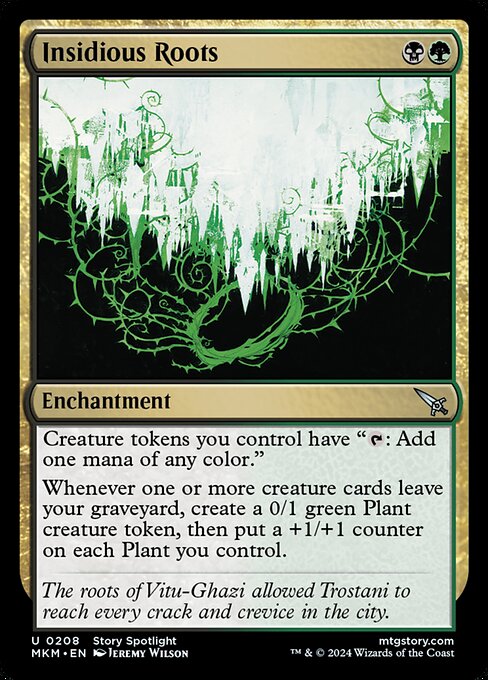
Top Performing Decklists
| Deck | Creator | Record | Best Finish |
|---|---|---|---|
| Abzan Roots | bryzem | 4-3 | None |
Performance Stats (Last 14 Days)
Win Rate Impact
Top Table Win Rate
Meta Trend
Sample Size
Tournament Results
Average Copies
Archetypes Using This Card:
Abzan Roots , Golgari Roots , Jund Roots , Jund Tokens , Sultai Cauldron , Unclassified , Unknown Archetype
Meta Performance Analysis
Insidious Roots ranks #175 out of approximately 310 cards in raw efficiency (top 56%).
Game Impact Factor
Color Differential
Multi average: 42.7%
Performance compared to other Multi cardsBased on our comprehensive multi-metric analysis, Insidious Roots is an underperforming card in the current meta.
Recommended number of copies: 1
Win Rate Timeline
Card Efficiency Analysis
Raw Efficiency (Win Rate/Mana)
Relative Efficiency
Performance Efficiency: 0.00 (Win rate × Top 8 rate ÷ Mana value)
At 2 mana, the average win rate in the format is 71.6%. Insidious Roots has a win rate of 57.1%, making it 20.2% worse than other 2-mana cards.
Top Performing Partners
| Card Name | Type | Deck Count | Win Rate | 1st Places |
|---|---|---|---|---|
| Insidious Fungus | Creature — Fungus | 8 | 47.9% | 1 |
| Ketramose, the New Dawn | Legendary Creature — God | 7 | 44.6% | 2 |
| Tranquil Frillback | Creature — Dinosaur | 10 | 42.4% | 2 |
| Skyfisher Spider | Creature — Spider | 13 | 40.0% | 3 |
| Osteomancer Adept | Creature — Squirrel Warlock | 27 | 39.7% | 3 |
| Coati Scavenger | Creature — Raccoon | 15 | 38.0% | 2 |
| Seed of Hope | Instant | 7 | 37.4% | 0 |
| Nissa, Ascended Animist | Legendary Planeswalker — Nissa | 11 | 36.5% | 0 |
| Overlord of the Balemurk | Enchantment Creature — Avatar Horror | 42 | 36.4% | 5 |
| Obstinate Baloth | Creature — Beast | 15 | 35.6% | 3 |
Card Synergy Analysis
Cards that perform better with Insidious Roots than they do on average. A positive synergy score indicates stronger performance together.
| Card Name | Type | Mana | Decks | Win Rate Together | Win Rate Apart | Synergy Score |
|---|
Top Archetypes
| Archetype | Deck Count | % of Archetype | Win Rate |
|---|---|---|---|
| Golgari Roots | 25 | 100.0% | 27.2% |
| Abzan Roots | 20 | 100.0% | 39.9% |
| Unknown Archetype | 5 | 1.6% | 14.0% |
| Jund Tokens | 3 | 100.0% | 16.7% |
| Sultai Cauldron | 2 | 66.7% | 58.3% |
Statistics Explanation
| Statistic | Description | Formula |
|---|---|---|
| Win Rate Impact | How much this card increases or decreases the win rate of decks that include it, compared to the average deck in the format. | (Win rate of decks with this card) - (Average win rate of all decks) |
| Top Table Win Rate | A weighted win rate that gives more significance to performance in higher tournament placements. First place finishes count for 2x, with diminishing weight down to 8th place. | ∑(wins × placement_weight) / ∑((wins + losses) × placement_weight) |
| Meta Trend | Shows if the card is performing better or worse in the most recent period compared to earlier periods. Positive values indicate improving performance. | (Win rate in recent half of time period) - (Win rate in earlier half of time period) |
| Confidence Factor | A measure of statistical reliability based on sample size. The progress bar indicates how confident we are in the statistics (with larger sample sizes providing higher confidence). | log10(Number of decks + 1) |
| Average Copies | The average number of copies of this card included in decks that use it. | ∑(Copies in each deck) / (Number of decks) |
| Card Synergy Score | Measures how well this card performs with other cards compared to their individual performance. | (Win rate together) - (Average of individual win rates) |
| Raw Efficiency | Win rate points per mana invested. Higher values indicate better returns on mana investment. | (Win rate) / (Mana value) |
| Relative Efficiency | How efficient this card is compared to the average card of the same mana value. | ((Win rate) / (Format average win rate for same mana)) / (Mana value) |
| Performance Efficiency | Combined metric that accounts for win rate, tournament success, and mana investment. | (Win rate × Top 8 placement rate) / (Mana value) |
| Game Impact Factor | A measure of how much this card affects game outcomes, based on win rate adjusted by its deviation from the format average. | Win rate × (1 + (Win rate - Format average) / 100) |
| Color Differential | How this card's win rate compares to the average win rate of other cards of the same color. | Win rate - Average win rate for same color |
All statistics are calculated using tournament data from the selected time period. Sample sizes below 10 decks may not provide statistically significant results.